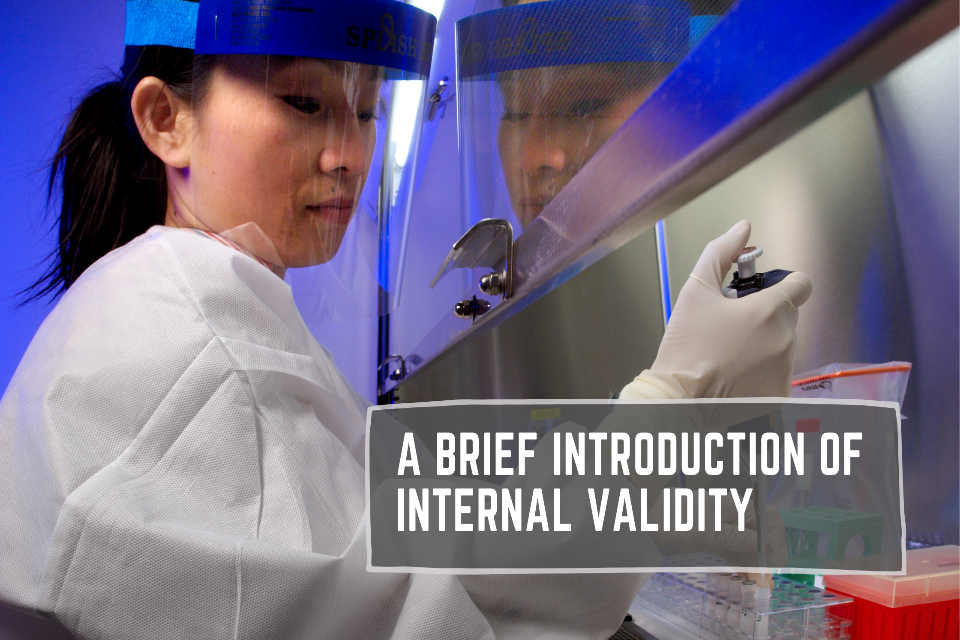A Brief Introduction of Internal Validity

The degree of certainty by which a cause-effect link can be established without being influenced by other factors in research is known as internal validity.
In simpler words, is it possible to establish a causal relationship between the treatment administered and the reaction of an experiment?
Why is internal validity important?
Internal validity lends reliability and validity to the outcomes of a causal connection. An experiment with a poor level of internal validity will not demonstrate a causal relationship.
Example of research
You want to see if consuming a cup of coffee helps you remember things. At the lab, you plan an equal ratio of volunteers from college for morning and evening classes. All morning session respondents are selected into the treatment group, whereas all respondents of the evening session are allocated to the control group.
Once they arrive, a cup of coffee is given to the treatment group members, whereas the respondents of the control group are offered a cup of water to drink. You also conduct memory tests for both the groups (Treatment and control group). After evaluating the data, you discover that the control group performed much more poorly than the treatment group.
Is it possible to infer that a cup of coffee enhances memory?
For the inference to be accurate, all other alternative explanations for the data should be ruled out.
How can you know whether your research has internal validity?
To prove internal validity, three requirements must be met. To empirically establish a causal relationship between a treatment variable A (independent variable) and a response variable B (dependent variable), each of the three requirements must be met.
1. Both the treatment and response variables are manipulated concurrently.
2. Adjustments in your response variables occur before treatment.
3. No confounding factor should explain the outcome of the study.
Only two of the three prerequisites have been satisfied in the research scenario above.
ü Coffee consumption correlated with improved memory performance.
ü Coffee was consumed before the memory test.
x Another extraneous factor is when the sessions are held that can also explain your results.
The groups were divided at the start of the research since the individuals were assigned based on the timetable. Therefore, any deviations in memory performance might be attributable to the time. As a result, it’s impossible to establish a cup of coffee or the time of the day that helps boost cognitive performance.
Such a scenario can indicate that your research has a poor level of internal validity, and you can’t draw any conclusions about a causal association between the consumption of coffee and memory performance.
Internal versus external validity trade-off
The amount to which the conclusions of research may be applied to other metrics, situations, or people is known as external validity. In simple words, is the result of your research generalizable to a broader context?
Internal and external validity are mutually exclusive; the more you control extraneous aspects of your investigation, the less you can apply your conclusions to a larger context.
Example of research
The external validity of your study on coffee and memory performance is determined by the memory evaluations chosen, the criteria for inclusion of the respondents, and the lab environment. Limiting your participants to college-aged individuals, for instance, improves internal validity at the cost of external validity, i.e., the study’s conclusions may only be generally applicable to students going to college.
Internal validity threats and how to deal with them
For successful research, internal validity challenges must be identified and addressed in the research design. Both single-group and multi-group studies are prone to a variety of challenges.
Studies with a single group
Example of research
A research group aims to see if installing indoor plants in office workstations increases the efficiency of a company’s IT personnel. For the month-long trial, each of the participating IT personnel is given a plant to keep at their workstations by the researchers. Before and after the study, all participants were asked to complete a timed productivity task.
|
Threat |
Meaning |
Example |
|
History |
An unconnected occurrence has an impact on the outcome. |
A week before the study’s conclusion, all employees were informed that they would be laid off. As a result, the participants are stressed on the post-test day, and their scores may decline. |
|
Maturation |
The study’s findings vary over a period as a natural outcome of time passing.
|
Most of the respondents were new to the job during the pre-test. It resulted in increased productivity due to the time spent in the job role. |
|
Instrumentation |
In the pre-test and post-test stages, several metrics are utilized.
|
Performance was evaluated for 15 minutes during the pre-test and half an hour post-test. |
|
Testing |
The pre-test results have an impact on the results of the post-test.
|
Because the same exam was given to all participants at the conclusion, they were more productive. In addition, many participants got great marks due to their acquaintance with the objective of the study or comprehension of the study’s goal. |
Threats to single-group studies and how to deal with them
In the case of single-group investigations, changing the experimental design can help mitigate the several challenges posed to internal validity.
- All hazards to single-group research are mitigated by including a similar control group. If similar treatment and control groups encounter the same hazards, the research’s outcome will not be impacted.
- A large sample size helps counter testing since the outcomes would be more vulnerable to any variation in the consequences.
- Testing hazards can also be mitigated by using filler tasks or surveys to conceal the study’s aim.
Multi-group research
Multi-group research example
The research intends to see if conventional flashcards or phone-based software effectively memorize vocabulary for the SAT. Based on foundation (pre-test) vocabulary scores, they split 11 students from one school into three categories. Group A utilizes the phone-based programme for 15 minutes a day, flashcards are used by Group B, and Group C utilizes the reading as a control. Assessments on post-test vocabulary are done three months later.
|
Threat |
Meaning |
Example |
|
Selection bias |
At the start of the study, the groups are not similar. |
Low-scoring individuals were assigned to Group A. Those who received better marks were placed in Group B. When there are systemic inequalities across groups, any improvements in their scores can be attributed to factors other than the treatment. |
|
Mean regression |
Individuals who scored extremely low or extremely high on the examination have a statistically significant bias to score closer to the average the following time they take the test. |
Because participants are separated into groups on the basis of their pre-test scores, it is difficult to determine whether the outcomes are related to the statistical criteria or treatment. |
|
Social interaction |
Respondents from other groups may share notes to discover the study’s purpose or to feel bitter about everyone else. |
Groups B and C may dislike Group A because they have access to cell phones during class. As a consequence, they may become demotivated and underperform. |
|
Attrition |
Participants who have dropped out
|
Unusable data was given by 20% of respondents.
They were almost all from Group C. As a consequence, comparing the control group to two treatment groups is difficult. |
In multi-group research, how do you deal with threats?
In the case of multi-group research, changing the experimental design can help mitigate many challenges to internal validity.
- If the groups are made similar at the beginning of the investigation, assigning individuals randomly to groups counteracts regression and selection bias to the mean.
- The impacts of social contact are reduced when participants are unaware of the study’s purpose.
Frequently Asked Questions
What do you mean by internal validity?
The definition of internal validity is how convinced you are that a cause-and-effect link discovered in research is due to the treatment and is not due to other factors.
How do you differentiate between external and internal validity?
External validity refers to the extent to which your findings may be applied to various situations.
Internal validity refers to the degree of certainty that the causal link under inquiry is unaffected by other variables and conditions.
How can threats to multi-group studies be countered?
Threats to multi-group studies can be countered by using blinding and random assignment.
Total Assignment Help
Incase, you are looking for an opportunity to work from home and earn big money. TotalAssignmenthelp Affiliate program is the best choice for you.
Do visit :https://www.totalassignmenthelp.com/affiliate-program for more details
Total Assignment help is an assignment help Online service available in 9 countries. Our local operations span across Australia, US, UK, South east Asia and the Middle East. With extensive experience in academic writing, Total assignment help has a strong track record delivering quality writing at a nominal price that meet the unique needs of students in our local markets.
We have specialized network of highly trained writers, who can provide best possible assignment help solution for all your needs. Next time you are looking for assignment help, make sure to give us a try.
Looking for Assignment Help from Top Experts ?
Get the best Assignment Help from leading experts from the field of academics with assured onetime, 100% plagiarism free and top Quality delivery.



